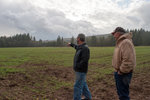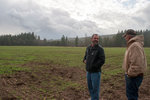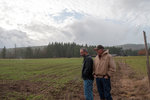


Dave Fenn has been a farmer in Lewis County for 44 years.
But as his commodity crops turned out to be not such a hot commodity — and buyers started drying up, Fenn began researching and studied alternatives to peas and corn, which he had been selling to National Frozen Foods, that would thrive in the southwest Washington climate.
Malting barley, in particular, and grains such as winter wheat and barley, stood out for several reasons. They could be grown in the spring or winter, malting barley is a high-value crop that can be easily rotated into a crop cycle, and most importantly, buyers of the malting barley have been identified.
Fenn’s farm in the Curtis area is currently growing 200 acres of malting barley that will be ready to harvest in July.
“If these farmers have, in the past, grown hundreds of acres of commodities, they’re not just going to scale down and start going to farmer’s markets,” said Mike Peroni, a project manager with Northwest Agriculture Business Center. “They have the infrastructure in place and the business acumen to be successful at that level of production. What (the farmers) really needed is help with identifying and developing an alternative market.”
Peroni is overseeing the Southwest Washington Grain Project, a partnership between the Port of Chehalis, the Office of the Chehalis Basin, Washington State University, Northwest Agriculture Business Center and others that have rallied together along with the farmers of southwest Washington to plan the construction of a grain storage and a transload facility at the Port of Chehalis to provide the farmers with greater access to buyers.
The Southwest Washington Grain Project was birthed out of urgency and slight desperation.
In 2018, Fenn and other area farmers learned their contracts with National Frozen Foods, a local corporation that packages frozen foods for retail sale, which they relied upon for their business, had not been renewed.
Paired with Symons Frozen foods in Centralia filing for bankruptcy in 2008 and the catastrophic flooding in 2007, the farmers in the area have been struggling. “To the best of my recollection there were 10 to 15 growers in Southwest Washington that contracted with National Frozen Foods,” said Fenn. Those farmers with farms ranging from 100 to 500 acres found themselves without a buyer.
Peroni said 2,500 acres of farmland in southwest Washington are at financial risk. Peroni emphasized that successful farms contribute to local economies while providing long-term ecosystem and recreation benefits as well as security to local communities.
“Maintaining the continual stewardship of the farm families that have operated these properties for so long is a way to secure our ecological future in this area … Part of Lewis County is the agricultural heritage — it’s part of the landscape,” said Peroni.
If a majority of farms in the area were to die out, there are many ancillary businesses in the area could also suffer.
The Thurston Economic Council and Washington State University are working to identify buyers for malting barley. Great Westren Malt in Vancouver is on board. Other potential buyers include the up-and-coming Tumwater Brewery District ,which will host many different breweries and South Puget Sound Community College that is building a facility for a brewing and distilling course, Peroni said.
The next phase of the project includes the construction of the grain storage and transload facility at the Port of Chehalis, which can transfer goods from truck to train or vice versa. The final storage capacity of the facility will be around 3,520 tons.
“There’s a different price between truck delivery and rail delivery. Partly because the buyers know that if you’re delivering by truck you probably don’t have ample storage so there’s an urgency in marketing that product. If we can aggregate and store grains, we can wait for the market to improve before we make the sale,” said Peroni. He also explained why malting barley needs an upright storage facility. “It can’t get skinned or broken. The buyers are looking for better than 90 percent germination all within a very specific window. It has to be consistent and extremely high quality.”
The Port of Chehalis has set aside 8.2 acres of land that has been dedicated to the transload and storage facility. The plans are to keep expanding the storage as demand grows in the future.
“We should have the rail reload facility built by the spring,” said Randy Mueller, CEO of the Port of Chehalis. “It will be a public facility that people can reserve with the port, where people can bring product in or send product out,” said Mueller.
The project is currently in the funding stage which is the main obstacle that stands in the way of beginning construction on the transload and storage facility.
However ,Mueller and Peroni are confident that the infrastructure will be in place before the 200 acres of malting barley are harvested. The Lewis County Board of Commissioners have provided $800,000 through the distressed counties fund for the installation of a rail spur. The project was also awarded a grant from the United States Department of Agriculture for business development for $32,656.
The project will be presented in the state Legislature for the forthcoming supplemental budget as well as next year’s capital budget. In order to begin phase one of building the storage and transload facility, $1.2 million is needed.
Peroni looks at the future of this project with positivity. He explained that breweries in the area are very interested in buying local.
“We want to start building this out so that we can start branding local product, branding the barley that has been grown here,” he said.
Like wine, beer made from Southwest Washington’s barley would be specific to the region and could be marketed based on the unique characteristics created only by the locally grown product.